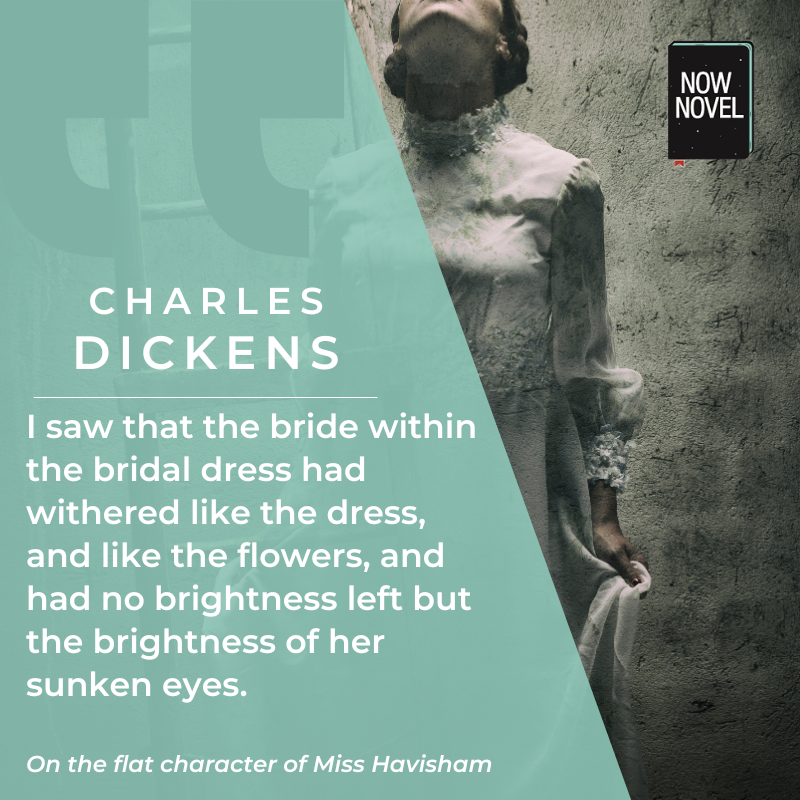While the main aim in telling a story might be to include round, complex characters in your story, it’s also equally important to include flat characters. In fact, some novels even contain a main flat character. An example of this is Agatha Christie’s Hercules Poirot’s detective mysteries. Poirot doesn’t change through the novels, and nor do we expect him to. His aim, as a character, is to solve mysteries. If he were to suddenly have an existential crisis, it would be very out of place in these books. He drives the narrative forward with his goal: i.e. solving a murder.
What is a flat character?
So, let’s define a flat character, before we delve further.
Flat characters, as the name suggests, are those that lack depth and development compared to round characters. Other terms used are dynamic and static characters. Read more on these terms, and how to create these characters.
Flat, or static characters, do not change, and we don’t necessarily want them to (as with Poirot). They are, quite often, two-dimensional, recognized by their simplicity and predictability. They often display a single personality trait or characteristic, with little to no evolution throughout the story. Unlike round characters who undergo transformation and possess multifaceted personalities, flat characters remain static, serving a specific purpose within the narrative framework (solving a murder, for example). Flat characters are drawn from well-known stereotypes and serve as sign posts for readers to understand who they are, and they might fit into the story being told.
EM Forster, in his seminal 1927 book, Aspects of the Novel, describes the terms round and flat:
Flat characters were called ‘humours’ in the seventeenth century, and are sometimes called types, and sometimes caricatures. In their purest form, they are constructed round a single idea or quality: when there is more than one factor in them, we get the beginning of the curve towards the round. The really flat character can be expressed in one sentence such as ‘I never will desert Mr. Micawber.’ There is Mrs. Micawber—she says she won’t desert Mr. Micawber, she doesn’t, and there she is.
(Forster is referring here to the character of Mrs Micawber in Charles Dickens’s David Copperfield.)
Why have flat characters?
As with the Poirot example given above, flat characters often propel the narrative forward. His goal of solving murders is what gives impetus to these books. Similarly, James Bond in the novels by Ian Fleming also doesn’t change through the novels: he is always the martini-loving spy who loves, and beds, beautiful women while in the pursuit of his criminals in his glamor-filled workdays.
However, of course, not all flat characters are main characters. In this case, flat characters often also serve as catalysts for driving the plot forward. They may introduce conflict, provide comic relief, or act as obstacles for the protagonist to overcome. They are there to support the main and rounded characters, and so enhance the telling of the story. Typically, they only have a few defining characteristics. This is in contrast to rounded characters with their backstories, sometimes convoluted inner lives, and the journeys (whether inner or outer) that they take in stories, and through which they are changed.

Characterization 101
Enroll in our free email course on characterization and discover how to create believable characters that enrich your narrative, no matter their role size.
Sign up freeFlat characters are useful in plot-driven stories such as science fiction or fantasy, for instance. Instead of bogging the narrative down in explanation, these characters can tell essential parts of the story.
An example of a flat character is that of Nick Carraway in The Great Gatsby by F. Scott Fitzgerald. Carraway is the narrator of this novel. He undergoes minimal development throughout the novel, serving primarily as an observer and a conduit for the events surrounding Jay Gatsby and Daisy Buchanan. But his perspective provides readers with a look into the extravagant world of the Jazz Age high rollers. Through his narration, this story of loss emerges.
Flat characters often also serve as catalysts for driving the plot forward. They may introduce conflict, provide comic relief, or act as obstacles for the protagonist to overcome.
Tweet This
Another reason to include these characters is that they embody archetypal or stereotypical roles within a story. These would include such characters as the wise mentor, the villainous antagonist, the funny wise-cracking person, the witness to a murder and so on. You wouldn’t want to develop these characters in depth. For example, you may have a pensioner, who is always peering out of her window, a snoop, always watching the streets, who witnesses the murder, and the detectives visit her a few times in the novel to go over what she saw. In this case she is the stereotypical witness. You don’t need to know her backstory, or much about her at all. You only need to have the information she has about the murder.
A further reason to have flat characters is to people your novel with atmosphere, a sense of place, adding to scene building.
Flat characters also serve as foils to round characters. A foil character is one who enhances another through their contrasts, accentuating and highlighting the qualities of the main character. This comes from the phrase meaning to back a gem in jewelry with a foil, metal that makes the gem shine more brightly. Sometimes these foil characters are in contrast to the protagonist, and may be the antagonist of the story (but not always).
A famous example of a foil character is that of Dr John Watson in Arthur Conan Doyle’s Sherlock Holmes stories. Holmes, the brilliant and eccentric detective, is often paired with his steadfast, even somewhat plodding companion, Dr Watson. Their contrasting personalities serve to highlight the strengths of each and ‘rub’ up against each other in terms of contrast. They certainly add to the enjoyable aspects of these timeless detective tales.
You can also use flat characters as symbols in stories, or in allegories that contain a moral. A famous symbol, and example of a flat character is that of Miss Havisham in Great Expectations by Charles Dickens. The jilted bride who keeps a mouldering wedding cake in her room years after being left at the alter, is symbol of stagnation, decay, and the destructive power of resentment. She lives in a crumbling home and wears a tattered wedding dress, and manipulates the protagonist, Pip. This depiction is a lesson about the need to let go of the past.
The description by Dickens of Miss Havisham is memorable and not easily forgotten!
I saw that everything within my view which ought to be white, had been white long ago, and had lost its lustre, and was faded and yellow. I saw that the bride within the bridal dress had withered like the dress, and like the flowers, and had no brightness left but the brightness of her sunken eyes. I saw that the dress had been put upon the rounded figure of a young woman, and that the figure upon which it now hung loose, had shrunk to skin and bone.
How to write flat characters
As we have seen above, flat characters are vital to any story, and can be memorable, vivid and interesting characters to create. Here are some pointers on how to write flat characters.
Define the character’s role in the story. How will they interact with the other characters and advance the plot or contribute to the themes?
Identify key traits or characteristics. Choose just one or two, and be consistent with them throughout the story. They should be clear, memorable and relevant to their role in the story.
Keep it simple. You don’t need to add backstory, for example, or show personality complexity. Focus on their behavior, as that is chiefly how they contribute to the story. Limit exposition
Keep your eye on the ball: i.e. always remember what impact they have on a story, and make sure that they contribute meaningfully to a story. Much like Chekhov’s Gun principle i.e. the idea that if there is a gun on a wall in scene one, it should go off in scene two, your flat characters must almost contribute to the story.
Be sparing in your inclusion of flat characters. Of course this all depends on what novel you are writing and how many cast numbers you have, but too many flat characters can overwhelm the main story and overshadow the main characters.
Writing stereotypical: While you may write stereotypes as flat characters, do also be mindful of avoiding overly simplistic or offensive portrayals.

Keep your writing sharp
and your characters sharper.
Subscribe to our blog newsletter for weekly insights into character development, narrative structure, and much more. Perfect for writers looking to enhance every aspect of their story, including flat characters.
Flat characters in literature
There are numerous examples of flat characters in addition to those mentioned above.
Here are a few examples.
Dean Moriarty in On the Road by Jack Kerouac. Dean Moriarty, the charismatic and free-spirited protagonist of Kerouac’s novel, is a flat character known for his wild antics and insatiable wanderlust. Dean’s character is defined by his reckless behavior and obsession with living in the moment, serving as a symbol of the Beat Generation’s rejection of conventional norms and values.
Christian Grey in the Fifty Shades of Grey trilogy by in E.L. James. Christian Grey, the wealthy and enigmatic protagonist of the series is controlling, possessive, and emotionally distant, with his character largely defined by his troubled past and BDSM preferences. Christian lacks significant depth or complexity, serving primarily as a fantasy figure for the protagonist, Anastasia Steele.
Holly Golightly in Breakfast at Tiffany’s by Truman Capote. Holly Golightly, the enigmatic and free-spirited protagonist of Capote’s novella, is a flat character known for her glamour, charm, and aloofness. While Holly is beloved by those around her, including the narrator, her true motivations and past remain elusive, leaving her character somewhat enigmatic and one-dimensional.
Primrose Everdeen, known as Prim, in The Hunger Games novels by Suzanne Collins. Although she undergoes some development in the series, she is a flat character. As the younger sister to Katniss serves to motivate and humanize Katniss, as well as to highlight the injustices and cruelty of the dystopian society in which they live. Prim’s characterization is relatively simple and consistent throughout the trilogy. She is depicted as gentle, compassionate, and nurturing, with a strong sense of empathy.
Learn how to write characters, both flat and rounded, with our characters guides, How to Write Real Characters Creating your Story’s Cast and How to write real characters: Character description.




2 replies on “The art of writing flat characters”
Thank you so much for this enlightening post. We hear a lot about rounded characters and character arcs that I think we lose the value of flat characters.
Dear Vivienne, thank so much for your feedback and commenting on the post. Yes, we often don’t realize that writing flat characters is essential too, in addition to rounded.